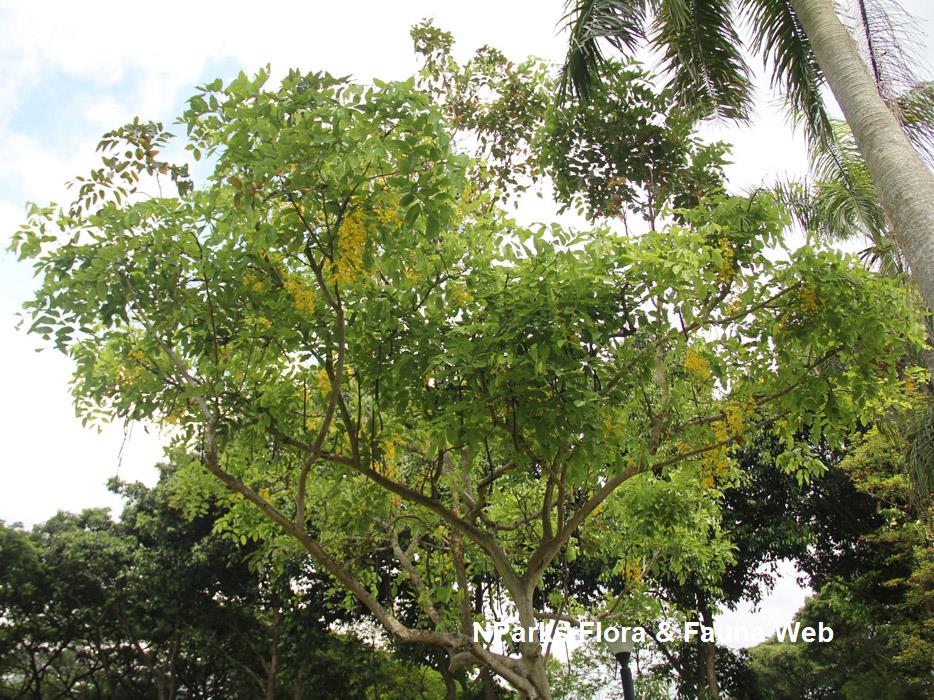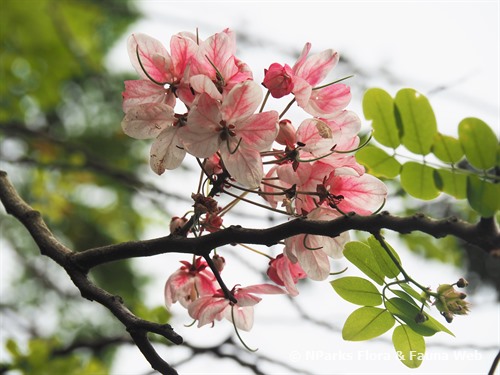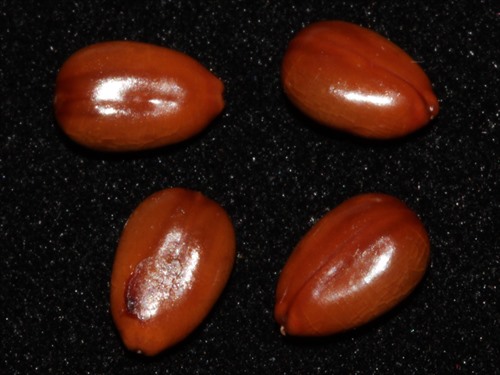
Back
Cassia fistula L.
| Family Name: | Fabaceae (Leguminosae) |
| Common Name: | Golden Shower Tree, Golden Shower, Shower Of Gold, Indian Laburnum, Purging Cassia, Rajah Kayu, Pudding Pipe Tree, Bereksa, 猪肠豆, 阿勃勒, 腊肠树 |
Aptly named the Golden Shower Tree, Cassia fistula has impressive blooms that drape from the crown and will sway gently in the breeze. Beyond the dazzling gold colour that the flowers add to the landscape, this sun-loving tree attracts butterflies and birds, enhancing the biodiversity around us. It is the national tree of Thailand and has gained popularity worldwide.
Name
Classifications and Characteristics
| Plant Division | Angiosperms (Flowering Seed Plants) (Dicotyledon) |
|---|---|
| Plant Growth Form | Tree (Medium (16m-30m), Small (6m-15m)) |
| Lifespan (in Singapore) | Perennial |
| Mode of Nutrition | Autotrophic |
| Plant Shape | Irregular, Open |
| Maximum Height | 10 m to 18 m |
Biogeography
| Native Distribution | India, Sri Lanka |
|---|---|
| Native Habitat | Terrestrial (Primary Rainforest, Secondary Rainforest) |
| Preferred Climate Zone | Tropical |
| Local Conservation Status | Non-native (Spontaneous (Casual)) |
Description and Ethnobotany
| Growth Form | Medium-sized tree with irregular crown. Deciduous, tree sheds leaves every 8 - 10 months, especially when flowering. |
|---|---|
| Foliage | Leaves pinnately-compound, consisting of 3 - 8 pairs of opposite leaftlets. |
| Flowers | Bright yellow, fragrant, produced in long pendulous clusters, 30 - 50 cm in length, attractive to insects and butterflies. |
| Fruit | Long cylindrical pods (40-60cm), black and indehiscent when mature. Seeds covered with edible, blackish-brown, pungent-smelling, sticky sweet pulp. |
| Associated Fauna | It is the host plant for Orange Emigrant (Catopsilia scylla cornelia) and Mottled Emigrant (Catopsilia pyranthe pyranthe). |
| Cultivation | Easy to grow. Propgate by seeds or marcotting of large branches. Prefers well-drained soil but tolerates most soil conditions. Long periods of drought induce flowering. |
| Ethnobotanical Uses | Edible Plant Parts : Edible Seeds Food (Herb or Spice) Medicinal: Nearly all parts of the plant have medicinal properties, used to treat a variety of ailments ranging from pimples, burns, wounds and colds to cancer. Seed pods and leaves used to treat diabetes and liver problems. Pulp from seed pod well-known for its mild laxative properties and used to relieve constipation. Timber & Products: Strong wood used to make cabinets, wheels, posts, mortars and firewood. |
Landscaping Features
| Desirable Plant Features | Ornamental Flowers, Fragrant (Flowers) (Day) |
|---|---|
| Landscape Uses | Suitable for Roadsides |
| Thematic Landscaping | Golden Garden, Naturalistic Garden |
Fauna, Pollination and Dispersal
| Fauna Pollination Dispersal Associated Fauna | Bird-Attracting, Butterfly Host Plant, Butterfly-Attracting |
|---|---|
| Pollination Method(s) | Biotic (Fauna) |
Plant Care and Propagation
| Light Preference | Full Sun |
|---|---|
| Water Preference | Moderate Water |
| Plant Growth Rate | Moderate |
| Rootzone Tolerance | Well-Drained Soils |
| Maintenance Requirements | Low |
| Diseases | Mildew, leaf spot, root rot diseases. |
| Propagation Method | Seed, Marcotting |
Foliar
| Foliage Retention | Deciduous |
|---|---|
| Mature Foliage Colour(s) | Green |
| Mature Foliage Texture(s) | Smooth |
| Foliar Type | Compound (Even-Pinnate) |
| Foliar Arrangement Along Stem | Opposite |
| Foliar Attachment to Stem | Petiolate |
| Foliar Shape(s) | Non-Palm Foliage (Ovate) |
| Foliar Venation | Pinnate / Net |
| Foliar Margin | Entire |
| Foliar Apex - Tip | Acute |
| Foliar Base | Rounded / Obtuse |
| Typical Foliar Area | Microphyll ( 2.25cm2 - 20.25 cm2 ), Mesophyll ( 45cm2 - 182.25 cm2 ) |
| Leaf Area Index (LAI) for Green Plot Ratio | 2.5 (Tree - Open Canopy) |
Non - Foliar and Storage
| Trunk Type (Non Palm) | Woody |
|---|---|
| Bark Colour(s) | Grey |
| Mature Bark Texture | Smooth |
| Root Type | Underground (Tap Root, Fibrous Root) |
Floral (Angiosperm)
| Flower & Plant Sexuality | Bisexual Flowers |
| Flower Colour(s) | Yellow / Golden |
|---|---|
| Flower Texture(s) | Thin |
| Flower Grouping | Cluster / Inflorescence |
| Flower Location | Axillary |
| Flower Symmetry | Radial |
| Inflorescence Type | Raceme |
| Flowering Period | A Few Times Yearly |
| Flowering Habit | Polycarpic |
Fruit, Seed and Spore
| Mature Fruit Colour(s) | Black |
|---|---|
| Mature Fruit Texture(s) | Smooth |
| Fruit Type | Indehiscent Dry Fruit , Pod |
| Mature Seed Colour(s) | Brown |
| Mature Seed Texture(s) | Glossy / Shiny |
| Seed Quantity Per Fruit | Moderate (6-10) |
References
| References | Larsen, K., Larsen, S.S., and Vidal, J.E. (1984) Leguminosae–Caesalpinioideae. In: Smitinand, T. & Larsen, K. (eds) Flora of Thailand. Vol. 4 (1), pp. 1 - 129. Bangkok: The Forest Herbarium, Royal Forest Department. |
|---|
Image Repository
Others
| Master ID | 1494 |
|---|---|
| Species ID | 2787 |
| Flora Disclaimer | The information in this website has been compiled from reliable sources, such as reference works on medicinal plants. It is not a substitute for medical advice or treatment and NParks does not purport to provide any medical advice. Readers should always consult his/her physician before using or consuming a plant for medicinal purposes. |

_lowres.jpg)
_lowres.jpg)
_lowres.jpg)















_lowres.jpg)

